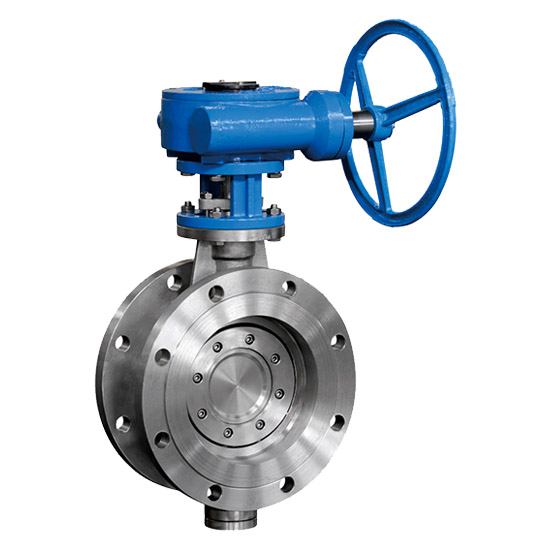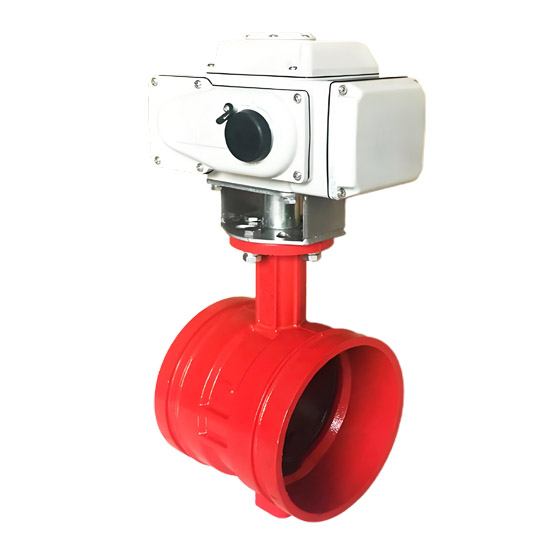1. Valve Overview
1.1 Product Definition and Application
The triple-offset metal-sealed butterfly valve is designed to control or shut off flow by rotating the disc around an eccentric shaft. Its core feature lies in the triple-offset structure:
First offset: The sealing surface centerline of the disc is radially offset from the valve seat centerline.
Second offset: The disc’s rotation axis is axially offset from the valve seat centerline.
Third offset: The sealing surface of the disc is inclined at a conical angle (typically 8–12°).
This design ensures that the disc fully disengages from the seat during operation, achieving frictionless metal-to-metal sealing only at the final closing moment. It is ideal for high-temperature, high-pressure, abrasive, corrosive, and particle-laden media.
Typical Applications:
Petrochemical, coal chemical, metallurgy, power generation (desulfurization, denitrification, steam pipelines), cement, mining, district heating, and water treatment systems. Especially suitable for two-phase flows (solid-liquid/gas-solid), particle-laden fluids (e.g. fly ash, slurry, crystallized solutions), and harsh conditions where conventional butterfly valves fail.
1.2 Model Code Interpretation
Example: D343H
D: Butterfly valve type
3: Actuation method (worm gear)
4: Connection type (flanged)
3: Structure type (triple-offset metal-sealed)
H: Sealing material (Cr13 alloy steel)
Other common models:
D373H: Wafer-type connection (space-saving)
D943H: Electric actuator
D643H: Pneumatic actuator
Sealing options: Y (hard alloy), X (rubber soft seal), etc.
2. Main Technical Parameters
2.1 Pressure Ratings
Nominal pressure: PN10, PN16, PN25, PN40, Class 150–2500 (ASME)
Strength test pressure: 1.5 × nominal pressure (≥15 min, no deformation or leakage)
Sealing test pressure: 1.1 × nominal pressure (≥15 min, no visible leakage)
2.2 Operating Conditions
Temperature Range:
Metal seal (Cr13/Y): –29°C to +425°C (short-term ≤550°C)
Tungsten carbide overlay: –46°C to +650°C
PTFE soft seal: –29°C to +200°C (clean fluids only)
Applicable Media: Water, steam, oil, natural gas, slurry, ore pulp, corrosive liquids (non-oxidizing acids), crystallized solutions, fly ash, pulp, and other particle/fiber mixtures
Materials:
Body/Cover: WCB, A105, CF8, CF8M, LCB, NACE MR0175
Disc: 304, 316, 2Cr13 (nitrided or tungsten carbide overlay), Duplex 2205
Seat: Spring-loaded floating seat with metal fire-safe backing (API 607/BS 6755 compliant)
2.3 Dimensions
Nominal diameter DN40–DN4000; flange dimensions per GB/T 9113 / ASME B16.5; weld ends per ASME B16.25; face-to-face length per GB/T 12221 or API 6D. Disc thickness and strength meet bidirectional zero-leakage sealing requirements.
3. Structure and Working Principle
3.1 Triple-Offset Design
First offset: Reduces friction during operation
Second offset: Ensures full disengagement of disc from seat
Third offset: Conical sealing surface creates wedge effect for tighter seal
Advantages:
Frictionless operation reduces wear and extends service life
Metal wedge seal compensates for thermal expansion and pressure fluctuation
Fire-safe design ensures sealing even if PTFE fails in explosive environments
3.2 Key Components
Body: Cast or welded steel, flanged or butt-welded ends, graphite gasket at mid-flange
Disc: Solid or hollow, precision-ground or tungsten carbide overlay
Seat: Spring-loaded floating design, dual-metal fire-safe backing
Actuation: Handwheel, worm gear, electric/pneumatic actuator; anti-static shaft supported by bearings
4. Standards and Certifications
Design Standards: GB/T 12238, API 6D, ASME B16.34
Testing Standards: GB/T 13927, JB/T 9092, API 598
Connection Standards: GB/T 12221, ASME B16.25
Special Certifications: API 607/6FA (fire-safe), ISO 15156 (sour service), EN 1797-1 (oxygen compatibility)
Hot Tags:






